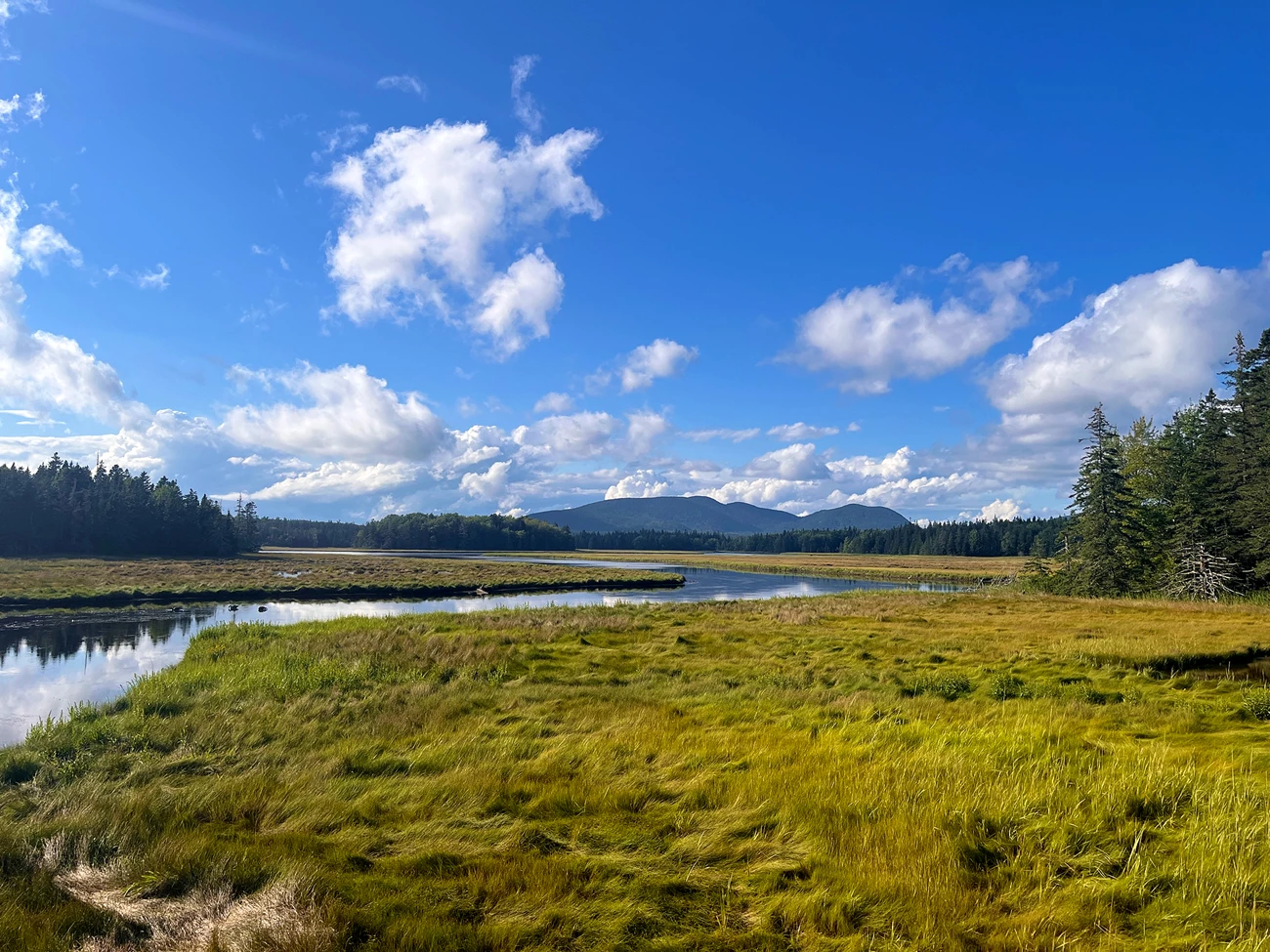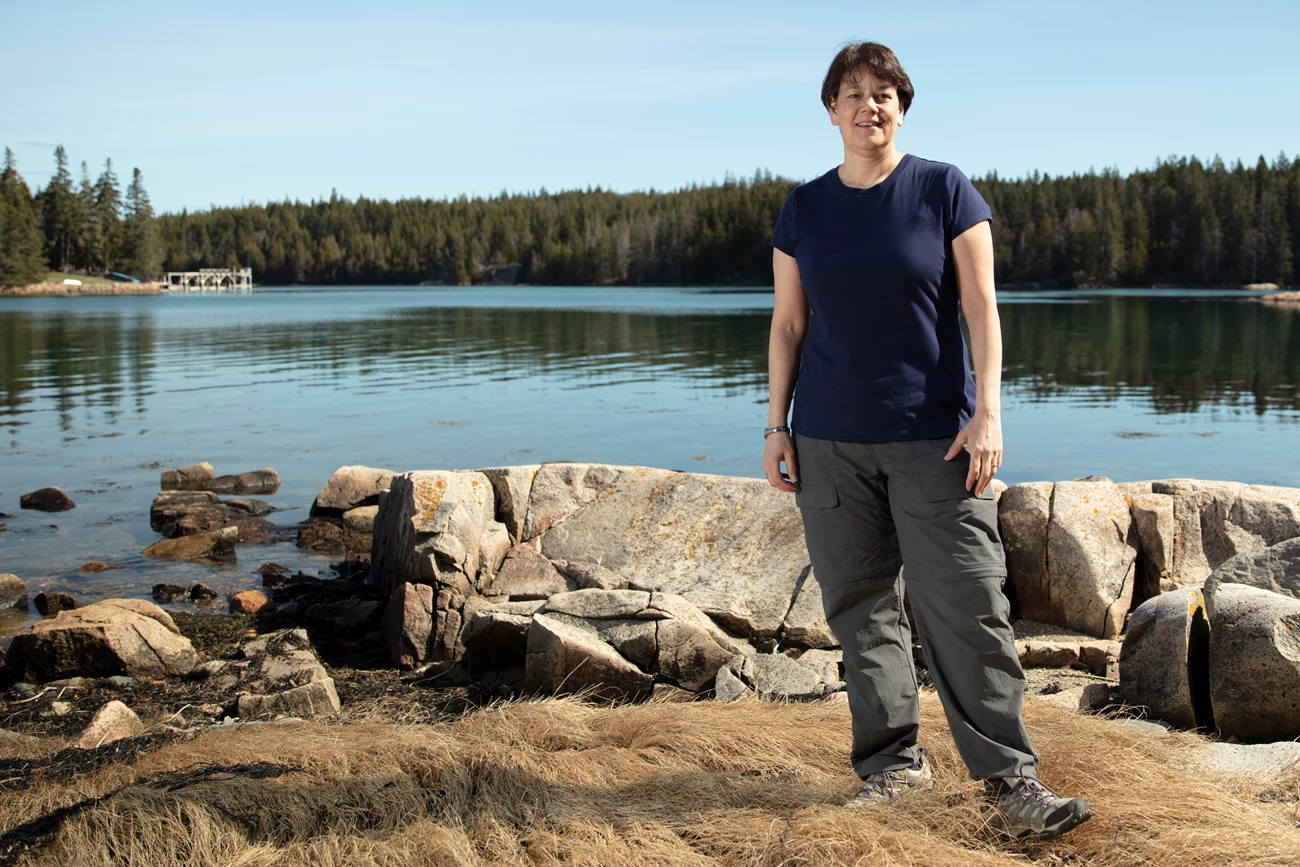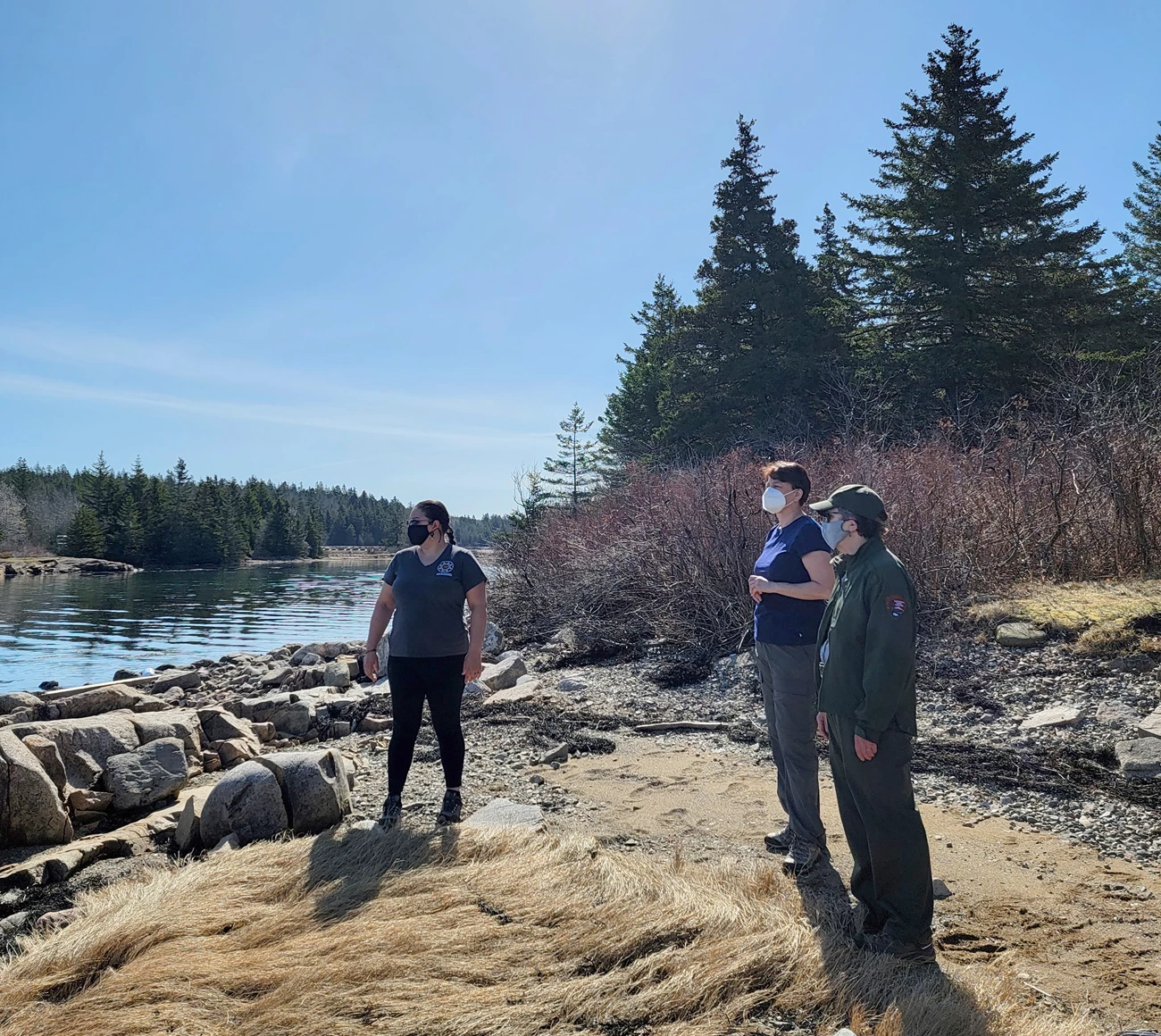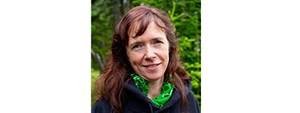Last updated: September 6, 2024
Article
Gathering Sweetgrass and Renewing the Past: How Science at Acadia Is Making a Course Correction
Wabanaki ecologists and archeologists conducting research in Acadia National Park are reframing narratives and reclaiming culture. Park science is all the better for it.

Image credit: NPS / Jonny Schmidt
Every summer, families come to their favorite places along the Maine coast to pick fragrant grass. They spend time together in the sea breeze, resting in the shade where the marsh meets the forest.
As they search and gather, they stimulate the grass to send up new shoots for future years. When they carry the grass home and fashion it into fancy baskets, braids, pottery, medicine, ceremony, and prayer, the fragrance lingers, an elusive blend of vanilla, salt, evergreen, and earth: sweetgrass.
A Prohibited Ritual
The Wabanaki, People of the Dawn—the Maliseet, Micmac, Passamaquoddy, and Penobscot—have lived in the Acadia region since time immemorial. Through their interactions with land, water, sea, and sky, they cultivate knowledge that sustains and transforms their identity. Gathering sweetgrass was once a common ritual along the shores of what is now the State of Maine. Wabanaki people have lost access to the coast as settlement patterns begun by European colonists continue to encroach on their traditional territories. For most of the last century, the federal government has prohibited Wabanaki people from harvesting sweetgrass within the boundaries of Acadia National Park.
In 2015, the National Park Service issued regulations for the gathering of certain plants or plant parts by federally recognized Indian tribes. This was a significant development for both national parks and the Tribes with whom they consult. It opened a path for Indigenous people to renew cultural practices and relations with valued places in their homelands. Under the National Environmental Policy Act of 1970, any harvesting agreement requires an environmental assessment and determination that there will be “no significant impact” to park resources. Scientific experiments must show that harvesting won’t harm plant populations or the surrounding ecosystem. In Acadia National Park, Wabanaki scientists and cultural experts have led the response to the rule change. Wabanaki communities have set the priorities for which plants to focus on, with sweetgrass being number one.
Suzanne Greenlaw is a Ph.D. candidate at the University of Maine and a member of the Houlton Band of Maliseets. “Requiring an environmental assessment is burdensome for Native communities,” she said. Science emphasizes objectivity, passive voice, random sampling and statistical analysis. It privileges the written word. In so doing, it perpetuates the power structure that disenfranchises Wabanaki knowledge, which is based on practical experience and oral communication. “The National Park Service is supposed to be using the best available science, but they often perceive the best available science as published research,” said Greenlaw. “This is a very narrow understanding of the natural world and often doesn’t support Indigenous practices as part of the science.”
Listening to Those Who Know
With National Park Service funding, Greenlaw is studying harvesting’s effect on sweetgrass growth in Acadia. She is working with Michelle Baumflek, a research biologist with the U.S. Department of Agriculture’s Forest Service, and fourteen Wabanaki sweetgrass gatherers and their families. Greenlaw came to the project after botanist Glen Mittelhauser of the Maine Natural History Observatory conducted an initial survey of sweetgrass in Bass Harbor Marsh. Bass Harbor Marsh is the largest salt marsh in Acadia.
Based on that initial survey, Mittelhauser and Baumflek established transects through patches of sweetgrass. Along each measured line, they planned to harvest some square-meter plots and leave others as controls. They would then return the following year to evaluate the plots by counting plant stems and measuring the length and weight of the harvested grass and the grass that grew back.
“The plots we designated for harvesting were not places where gatherers actually wanted to harvest, that they would have chosen themselves.”
Everything was ready on the summer day when the gatherers came out to harvest. But very quickly, everyone involved realized there was a problem with Mittelhauser and Baumflek’s study methods. “The plots we designated for harvesting were not places where gatherers actually wanted to harvest, that they would have chosen themselves,” said Baumflek. “Not only was it unintentionally disrespectful, it did not allow the gatherers to express their knowledge and connections to sweetgrass, which was the goal of the study.”
Greenlaw and Baumflek revised this approach, adding a parallel experiment. In this one, the gatherers selected the harvest locations, collecting sweetgrass as they always had, with varied preferences for grass length and harvest technique. The researchers then set up square-meter plots and control plots in those locations. And they followed the gatherers as they harvested, conducting interviews in the field.“
A key component of the Wabanaki-led approach was to listen to the gatherers,” said Acadia National Park program manager Rebecca Cole-Will. “Suzanne and Michelle interviewed them as they gathered. This approach opened up a vast amount of knowledge about sweetgrass, how it is harvested, how marshes are assessed for health and sustainability, and why the act of gathering is so culturally significant.”

Image © Schoodic Institute / Elliot Higger
Reclaiming Culture—Before It’s Lost
Gatherers, harvesters, hunters, and healers have lost knowledge as a result of being kept out of national parks and prevented from accessing their own history, their own lands and waters. The loss is accelerating as parks are affected by overcrowding, pollution, and a changing climate.
Sweetgrass grows at the upper edge of salt marshes, a transition zone that is shifting and could disappear as sea levels rise. Higher seas and more intense storm waves threaten other Indigenous cultural spaces in Acadia. Most of the 24 documented archeological sites in the park are coastal shell mounds that are hundreds or thousands of years old. One set of sites at Isle au Haut dates to 4,000 years ago. The National Park Service recommended these sites for inclusion in the National Register of Historic Places as a historic district. But it withdrew the recommendation, because erosion had affected the sites’ integrity.
The archeological sites at Isle au Haut are among the few that have been studied, decades ago. The National Park Service locked away excavated materials from these sites in 1981 and designated the reports as confidential and unavailable to the public. Like access to the sweetgrass fields, accessing historic records has been a challenge for the Wabanaki. Bonnie Newsom, an archeologist and assistant professor at the University of Maine, is a member of the Penobscot Nation. “By assuming authority over the management of Wabanaki heritage, archeological practices have distanced communities from their own culture,” she said.
Newsom is supported by a Second Century Stewardship Fellowship. She is re-evaluating the park’s collections from two previous archeological excavations, including the sites at Isle au Haut. Wabanaki interns Isaac St. John of the University of New Brunswick and Natalie Dana-Lolar of the University of Maine are assisting her. They have retrieved the materials from storage for re-examination and interpretation. They intend to write a new and accessible report summarizing the sites’ contents and their meaning. “Wabanaki people have a history of being relegated to the periphery of archeology,” said Newsom. “This project puts Wabanaki people at the forefront of the research.
“Often we don't use that term ‘family’ in archeology; we use terms like ‘occupants’ or ‘inhabitants.’ But when we call them families, it humanizes them, and it allows us to reconnect on a level of kinship.”
Changing the narrative is an important aspect of Newsom’s work. “We are all trained in Western models of archeological research,” said Newsom. “But we are making a deliberate shift in how we talk about past people and places and materials, because the terms that people often use are not ours.” For example, archeologists and historians often refer to shell mounds as “middens,” but that term is linked to garbage or waste piles. “From a Wabanaki perspective, this may not be an accurate description of shell-bearing sites,” said Newsom. “These spaces are so much more than that.”
Fragments of decorated clay and pieces of flaked stone are not only archeological “potsherds” and “bifaces” but also art and gifts from Wabanaki ancestors. Archeological collections reflect past lifeways of Indigenous families. “Often we don't use that term ‘family’ in archeology; we use terms like ‘occupants’ or ‘inhabitants.’ But when we call them families, it humanizes them,” said Newsom, “and it allows us to reconnect on a level of kinship.”
The Second Century Stewardship project is personal for Acadia National Park program manager Rebecca Cole-Will. She spent her first season as a professional archeologist working on the same sites that Newsom, Dana-Lolar, and St. John are now evaluating. “The place where I was and where archeology was at that time had nothing to do with the Indigenous people who live here today,” said Cole-Will. “There was never any thought for the people and their participation in the history of this place. When we talked about culture, we weren’t talking about people at all, we were talking about archeological constructs of what culture was.”

Image © Schoodic Institute / Catherine Schmitt
Expanding Understanding
By reframing science and its language around human action and agency—around culture—Indigenous approaches bring deep place-based connections and multi-generational knowledge to help answer research questions. In the Second Century Stewardship study, identifying Wabanaki language terms to describe cultural materials has helped Dana-Lolar and St. John advance their language skills while also inspiring new archeological interpretations.
For example, the word for clay pot in the Passamaquoddy language is “qahqolunsquey,” which is animate (meaning the clay pot is alive), like terms for people and animals. A clay pot is not an empty vessel, but a holder and transferrer of liquid—nourishment, perhaps, or healing. “Exploring why clay pots fall into the animate category, the role of particular items in daily life, helps us as archeologists understand the perceptions of Indigenous people in the past,” said Newsom, who specializes in ceramics. Artists sometimes incorporated crushed shell or balsam fir needles into clay, messages of beach or forest carried from past to present.
"We created an experiment and thought we could just plug in the gatherers. We didn’t know that all sweetgrass isn’t the same.”
The sweetgrass project also shows how Indigenous scientific approaches can generate new thinking—and more accurate results. Previous studies by Robin Wall Kimmerer, Laurie Reed, and others had demonstrated that just as a lawn grows back thicker after being mowed, stem density increases after harvest of sweetgrass. According to preliminary findings presented by Greenlaw and Baumflek at the 2021 Acadia National Park Science Symposium, the plots selected by the gatherers had, on average, a 30 percent increase in stem density after harvest. The botanist-selected plots, however, had no change.
“This showed we had a problem with our initial study design,” said Glen Mittelhauser. “We did not take into account the toll to the plants that stem counting had along the transects. And we failed to account for the types of sweetgrass that gatherers preferred to harvest. We created an experiment and thought we could just plug in the gatherers. We didn’t know that all sweetgrass isn’t the same.” The gatherer-led approach was a more realistic representation of what the study was supposed to evaluate.
Shared Stewardship Benefits Everyone
In November 2021, President Biden committed to incorporating Indigenous traditional ecological knowledge in federal scientific and policy processes. In a memorandum, the White House recognized Indigenous knowledge for its contribution to the “scientific, technical, social, and economic advancement of the United States and our collective understanding of the natural world.” The White House cited the Acadia National Park sweetgrass study in the memorandum as an example of knowledge collaboration between Native communities and the federal government.
Greenlaw said that another difference with Indigenous-led science is that Wabanaki scientists are responsible for the outcomes of their research, which affect their communities.
As part of their reciprocal research approach, Greenlaw and Baumflek organize an annual gatherers’ workshop to share results and collectively work on the permit process for sweetgrass gathering. Their goal is the renewal of cultural practice. As Penobscot sweetgrass gatherer Kyle Lolar said at the 2021 Acadia science symposium, “Sweetgrass is one of our four sacred medicines, a connection between two worlds, and now we are starting to re-establish those roots once again.”
For Newsom, the ultimate purpose of the research is to share with her community information and materials about their ancestors. “Strengthening our cultural heritage,” said Newsom, “makes our communities more resilient and renews our ability to act as responsible stewards of our homelands.”
Greenlaw and Newsom are helping to redefine stewardship of the lands and waters that are now national parks, an effort that benefits everyone. But it is just beginning.

About the author
Catherine Schmitt is a science communication specialist with the Schoodic Institute at Acadia National Park. Image courtesy of Catherine Schmitt.
